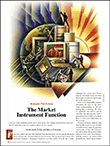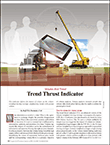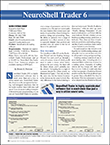Letters To The Editor
October 2011 Letters To The Editor
The editors of S&C invite readers to submit their opinions and information on subjects relating to technical analysis and this magazine. This column is our means of communication with our readers. Is there something you would like to know more (or less) about? Tell us about it. Without a source of new ideas and subjects coming from our readers, this magazine would not exist.
Address your correspondence to: Editor, Stocks & Commodities, 4757 California Ave. SW, Seattle, WA 98116-4499, or E-mail to editor@traders.com. All letters become the property of Technical Analysis, Inc. Letter-writers must include their full name and address for verification. Letters may be edited for length or clarity. The opinions expressed in this column do not necessarily represent those of the magazine. —Editor
Market Instrument Function
 Editor,
Editor,
I am looking for more information on the market instrument function, which was
described in an article by the same name in your December 2010 issue. Is this forecasting tool built into any trading software? How can authors A. Ershov and A. Gerasimov be contacted for updates and additional information?
Walter Schramm
Please see the February 2011 and April 2011 issue Letters To S&C columns for some follow-up information on the market instrument function and a correction on one of the figures. If you don’t have these back issues, you will find those Letters To S&C columns at our website, www.traders.com.
You can contact authors Aleksey Gerasimov (avgerasimov@umail.ru) and Alexander Ershov (amershov@umail.ru) by email.—Editor
The V-Bottom Buy Setup
Editor,
I read Jamie Theiss’ article, “The V-Bottom Buy Setup,” in the August 2011 issue, and I believe he has uncovered a setup that looks promising. I am interested in writing some code to automate this technique in TradeStation. However, to code it, I need to define the ranges. (When defining a range, I believe it is always better to use percentages, since a 10-cent move on a $50 stock is much different than a 10-cent move on a $10 stock.)
While I intend to set most of the parameters as inputs to make them variable for backtesting, I wonder whether the author has or can set some guidance on the ranges to be used. Here are some of the specifics I would like to ask him, referencing quotes from his article:
- “The selloff has to be at least five consecutive red bars down.” I can easily set this as a minimum. I question whether there is a maximum number of down bars at which point the author would abandon the process. I notice in his example in the article he shows six down bars.
- In his example, the open appears to be lower than the previous bar’s close in each case. Is this a requirement or a coincidence? Would it suffice if the close of the current bar is simply less than the close of the previous bar, even though the open of the current bar was greater than or equal to the close of the previous bar?
- “The bars also gain in size toward the end of the move...” Could you define the end of the move? Does it refer to the last two bars being greater than the prior two, as in Figure 1? In Figures 2 and 3, is the last down bar actually less than the three preceding bars? Is there a formula I can use to define this statement (such as: the average of the [close - open] of the lower half of the bars should be greater than the average of the first half of the bars)? Would there also be a minimum percentage difference to look for or a minimum dollar amount?
- “...as volume increases.” Again, is there a minimum increase in volume that must be achieved? Must it be greater than 1, 10, 100, 1,000, or 10,000 shares, or a certain percentage increase?
- “The bars also resemble a waterfall...” Would it be better to consider the slope of the close to close, open to open, open to close, or even consider the bars’ highs and lows?
- What would be the minimum acceptable slope as measured by one of the conditions referenced above? Elsewhere, when defining a power trend, the author states: “... they are closer to a 45-degree angle down, not a vertical as in the selloff.” What should I use as a cut-off angle: 40 degrees? 42 degrees?
- “...and show significant separation from the moving averages.” Again, here it would be nice to define “significant.” Should that significant separation be measured from the lowest of the moving averages as it relates from the first bar to the last bar? Once again, does the author have a certain dollar amount he uses, or would he look to a specific dollar amount? Does the significant separation need to manifest itself with the second bar and continue through the last down bar, or may it simply be determined by the first or last bar’s separation?
- “Now in Figure 2 you see a neutral bar...” My question is, must we have a “neutral bar” precede the entry event, or would any green bar with a high greater than the high of the previous bar count as a trigger?
- “...with almost equal wicks..” Again, could you define “almost” as used in this sentence? Is it within a certain percentage difference or dollar amount? Are the wicks necessary, and if so, must they be of a certain minimum size, either in dollar amounts or as a percentage of the open and close?
Sam Stein
Author Jamie Theiss replies:
Thanks for reading. While I can appreciate you wanting to write code to automate your trading, unfortunately, I am not the person to ask! I am more in the camp of “trading as an art, not a science.” While some setups are more easily quantifiable, this one is not. This setup is more along the lines of “you’ll know it when you see it” in the blink of an eye. But I will try to answer your questions as best I can regarding the specifics of the technique.
- There is no maximum, although I suppose at some point it would become futile to continue to wait for the reversal signal. But then again, after eight to13 bars down, given the other considerations of growing bigger as they fall, it “has” to reverse somewhat and sometime, doesn’t it? Otherwise, the other criteria start to disappear.
- It is a coincidence. But that is the consequence of the fear-based selloff. The price is falling fast and faster.
- As fear increases, so does the selling. That is why they get bigger toward the end. The last bar is smaller because that is the bar of indecision and possible reversal. I also mentioned in the article that a narrow-range bar and bottom-tail bar are also signs of reversal.
- I can’t give a percentage. It just increases because fear is taking hold and more people are getting sucked into it until there are just no more sellers. That is when the buyers come in and drive it back up.
- For me, it is just a visual thing: a vertical waterfall versus a 45-degree power downtrend.
- Same as #5. Sorry, but as I said, I’m more “art” and less quant.
- The best I can describe is to look to the left on the chart. Is there significant or big or extreme separation? When you see it enough times, you just know it.
- As in #3, it’s best to have a reversal bar simply for position sizing. If the last bar is also the biggest bar, and it is reversed by a green bar, the stop would be very big and your share sizing would be small. Better to have a small reversal bar so you can share size to it. Wouldn’t it be great if that last bar were only five cents wide? You could really load up on your shares and get a fantastic return while keeping the dollar risk the same.
- The wicks show indecision. “Almost” the same shows indecision. As in #8, it would be best not to have any wicks be able to get a bigger share size with the same risk. I also wrote that bottom-tail bars are also an excellent reversal signal.
As I said, I can understand your wanting to automate your trading. For some, like big institutions, banks, hedge funds, and so on, it might be wise or even necessary to automate trading. I happen to believe it can actually be counterproductive to automate your trading. I think people want to remove themselves from the pain and frustration of trading and think automating it will make it painless. But I think it is vital and necessary to experience firsthand all the pain, frustration, self-doubt, and desire to quit when it gets difficult before you start to become a consistent winner.
Trading is all psychology. By quantifying it, you are simply transferring your psychology into code. And if your psychology is flawed, then the code will be flawed. And you can only fix your psychology by trading real money, in real time, and pushing the buttons on your own. If you can’t do that profitably, you can’t code correctly.
Of course, this is just my opinion, but it is an opinion born out of the experience of losing and feeling all those bad things, and trying to automate my own trading so I wouldn’t have to feel bad when I lost.
Again, just my opinion, but I think backtesting is a waste of time. There is no psychology involved. It would be far better to just take a real trade. You will learn exponentially more in that one trade than all the backtesting in the world.
TREND THRUST INDICATOR
 Editor,
Editor,
I am a long-term subscriber to your magazine. This is my first letter to the editor. It concerns the recent article, “Trend Thrust Indicator,” by Buff Pelz Dormeier (August 2011 S&C).
The author has done an excellent job of discussing the results using his indicators. However, he does not give the formulas for his methodology in an easy-to-understand manner. I don’t believe I could reconstruct the formulas for his indicators without a lot of work and guessing.
As such, since I can’t duplicate his results, I find the article totally useless.
William D. Martin
Huntsville, AL
Although enough detail was provided in the “Trend Thrust Indicator” article to replicate the technique, it was not encoded in a convenient form. To remedy that, author Buff Dormeier has provided EasyLanguage code for his trend thrust indicator (Tti) as well as for his volume-weighted simple moving average (Vwma), which was described in his February 2001 Stocks & Commodities article, “Buff Up Your Moving Averages.”
We have posted both sets of code to our website in the Subscribers’ Area (login is required). To navigate to the Subscribers’ Area, go to our homepage at www.traders.com and click on “Article Code.”
Dormeier also notes that the trend thrust indicator and many of his other indicators are available in Worden Brothers’ StockFinder program if you are registered through his website at https://VolumeAnalysis.com. In addition, MetaStock is apparently working on the Tti as an add-on that should be available soon, also through VolumeAnalysis.com.—Editor
ERRATUM: NEUROSHELL TRADER 6 PRODUCT REVIEW
 In our review of Neuro�Shell Trader 6 in the September 2011 issue, we incorrectly listed the hours for customer support. Hours are actually 9 am to 5 pm Monday–Thursday Eastern time (ET), and Friday from 9 am to 4 pm.
In our review of Neuro�Shell Trader 6 in the September 2011 issue, we incorrectly listed the hours for customer support. Hours are actually 9 am to 5 pm Monday–Thursday Eastern time (ET), and Friday from 9 am to 4 pm.
We regret the error.